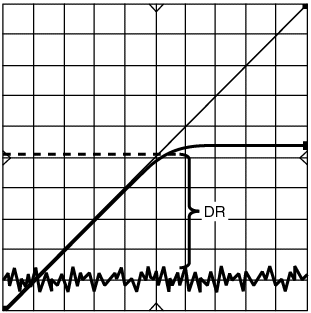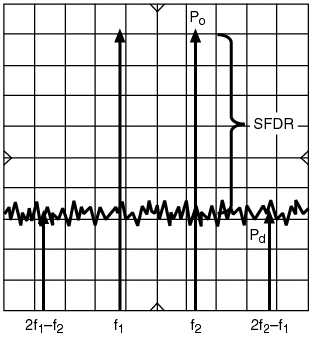Dynamic Range
Dynamic range is the range between the minimum detectable signal (in this case the noise floor) and the -1 dB compression point, as shown in the following figure.

Dynamic range is expressed with the following equation:
DR (dB) = P1dB(dBm) – Noise Floor (dBm/Hz)
Another term often used to describe the dynamic range is the spurious free dynamic range (SFDR). In the traditional sense of an amplifier or transmitter, SFDR is the level at which the intermodulation distortion (IMD) products are equal to the noise floor. Therefore, the input signals are adjusted such that the difference between the desired signals and the noise floor is equal to the difference between the desired signals and the spurs. The following figure is a graphical representation of the SFDR.

The SFDR can be calculated from the third order intercept (TOI) point and the second order intercept (SOI) point using the following equations:
SFDRTOI = 2/3(OIP3 – Noise Floor)
SFDRSOI = .5(OIP2 – Noise Floor)
Using the NI 5610 upconverter module as a stand-alone unit, maximize the SFDR using the same procedure used to maximize the TOI. This procedure minimizes RF attenuation.
When using the NI 5610 upconverter module in conjunction with an AWG module as a calibrated RF signal generator, the SFDR for a two-tone signal is the difference between the desired tones and the intermodulation levels. This value can be calculated from the TOI and SOI using the following equations:
IMDTOI = 2(OIP3 – Pout)
IMDSOI = OIP2 – Pout
| Output Power (dBm) | Noise Floor (dBm/Hz) | TOI Products (dBc) |
|---|---|---|
-20 | -140 | -86 |
-6 | -126 | -86 |
5 | -115 | -54 |